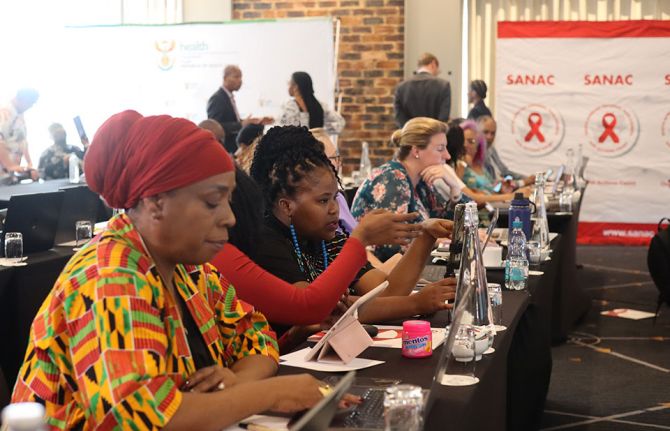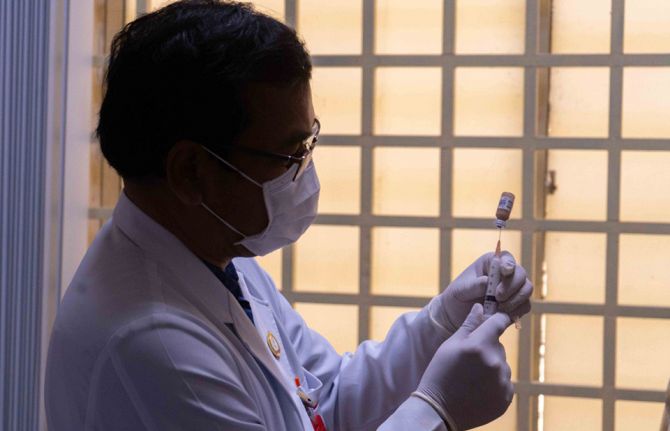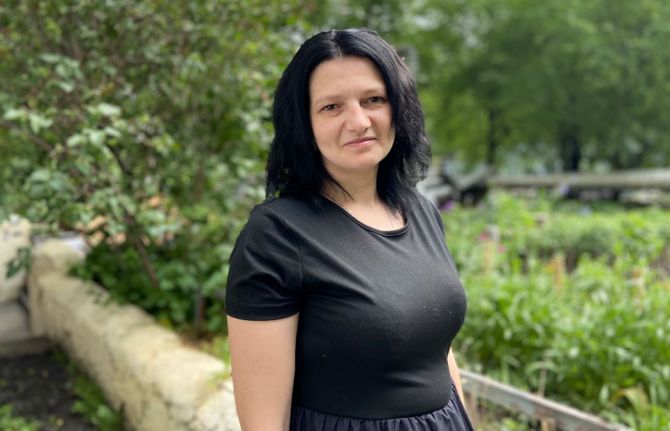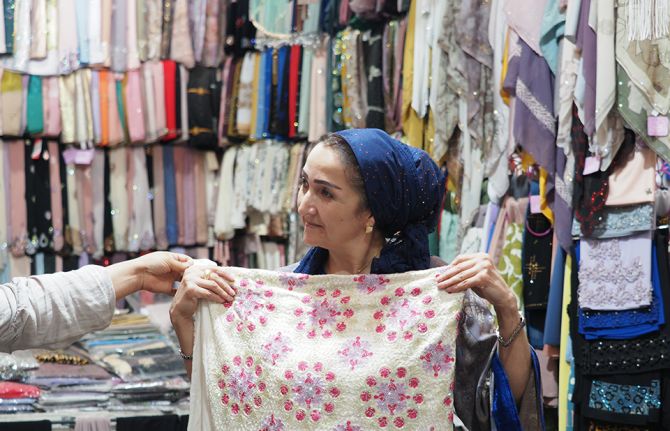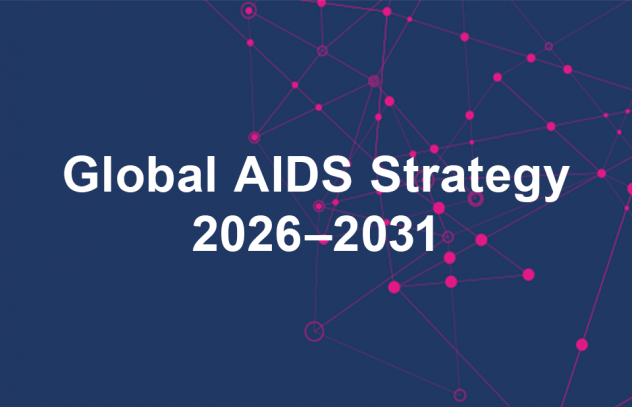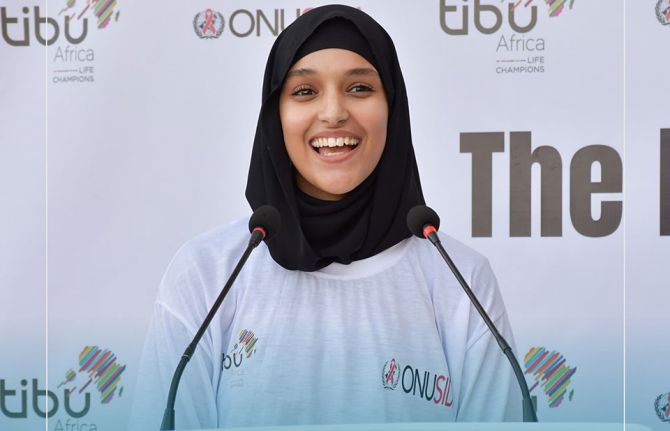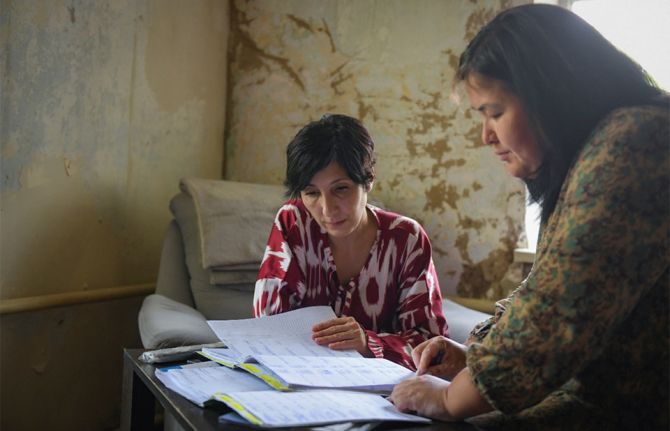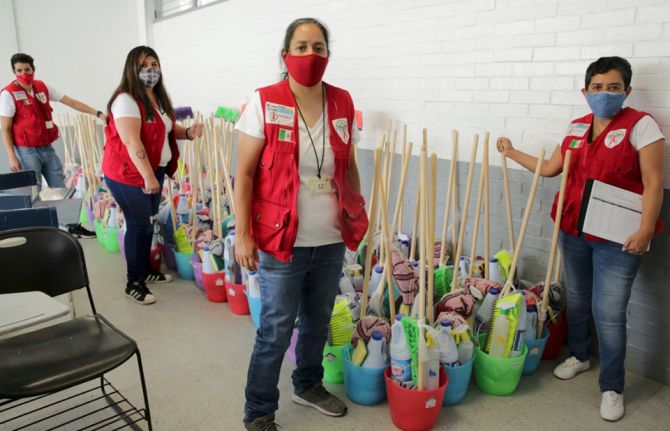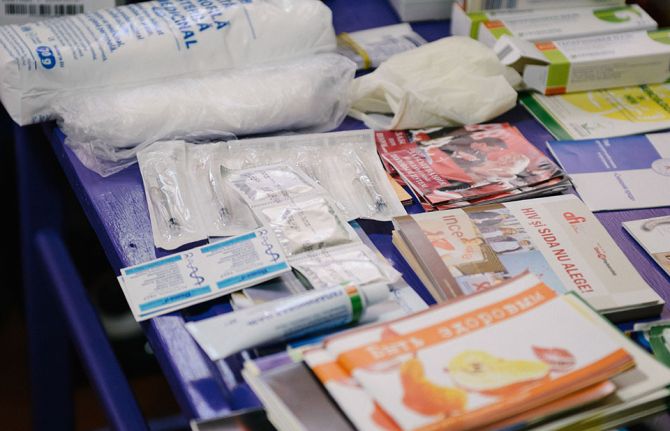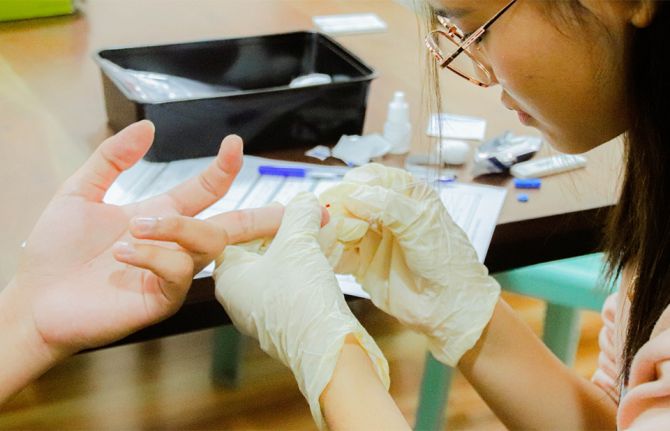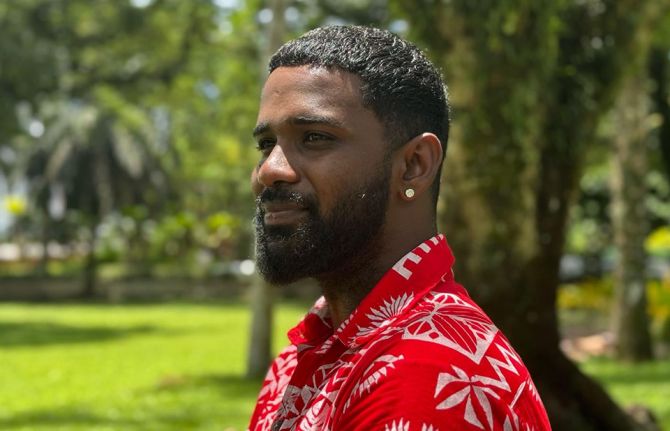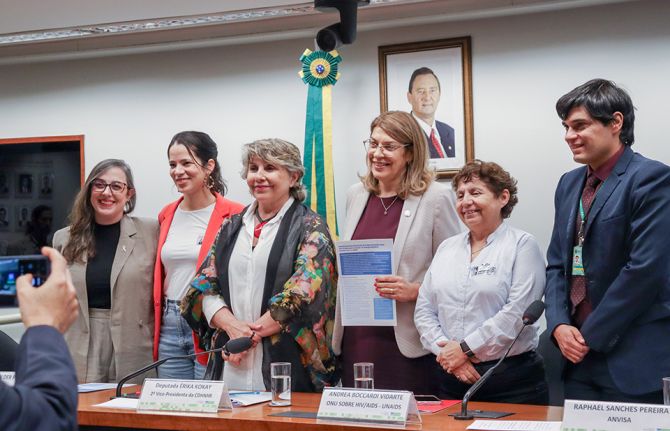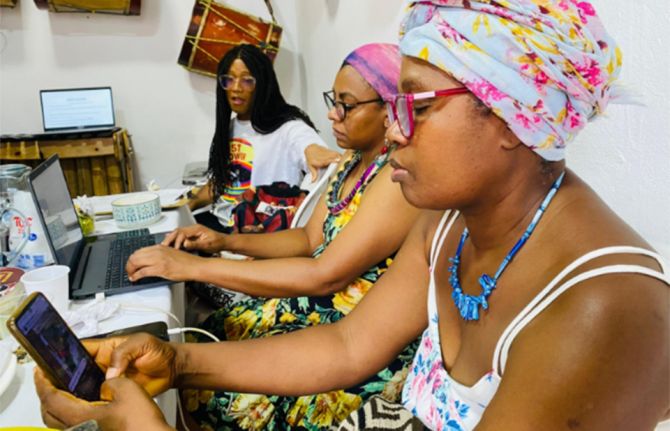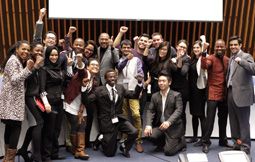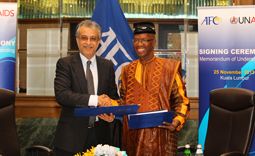
Feature Story
UNODC project provides cross-border HIV services to Afghan injecting drug users
16 April 2010
16 April 2010 16 April 2010
To help successfully implement the project and build the capacity of NGO staff and government officials, five days of training in HIV took place in Kabul.
Credit: UNODC
Providing comprehensive HIV services for injecting drug users is critical to an effective HIV response. In recognition of this, the United Nations Office on Drugs and Crime (UNODC) has begun to support the implementation of an initiative to make services accessible to Afghan refugees who inject drugs in Iran and Pakistan, and also to Afghan injecting drug users who have returned home.
The use of non-sterile injecting drug equipment is one of the most efficient modes of HIV transmission and remains one of the critical activities fuelling HIV epidemics among drug users. HIV can also spread from people who inject drugs to their sexual partners and other populations at higher risk of HIV exposure such as sex workers.
The project aims to create an environment that supports a cross-border regional network of HIV services so that Afghan refugees will be able to access HIV services when they go back to their country. UNODC awarded two grants to non-governmental organizations to provide services to Afghan drug users in Herat province, bordering Iran and Nangarhar, which borders Pakistan.
Khatiz Organization for Rehabilitation in Herat and the Health and Social Development Organisation in Nangarhar are using mobile outreach units to offer a wide-ranging set of servcies. These include facilitating specific information and education materials for drug users; distributing clean needles and syringes; promoting and distributing condoms; treating and helping prevent sexually transmitted infections; primary healthcare such as HIV voluntary counseling and testing services and antiretroviral treatment.
Training in HIV and drug use
To help successfully implement the project and build the capacity of NGO staff and government officials, five days of training in HIV took place in Kabul. Doctors, nurses, social workers, project managers and employees from the women’s prison participated.
During the meeting, also attended by high-level delegations from the government, UN agencies and NGOs, the seriousness of the situation in Afghanistan was discussed. Dr.Mohammad Zafar, Deputy Minister of Counternarcotics, told the gathering that according to a 2005 UNODC survey, the country has one million drug users, including 19 000 – 25 000 who inject drugs, making up 3.8% of the total population.
According to Dr.Ajmal Sabaoon, National AIDS Control Programme Manager, Afghanistan is moving from a low-level HIV epidemic towards a concentrated epidemic. He briefed participants on results of an Integrated Biological and Behavioral Survey conducted by John Hopkins University in 2009, which indicates that HIV prevalence among injecting drug users in three major cities of the country (Kabul, Herat and Mazar) has increased from 3% to 7% from 2007 to 2010.
Knowledge of HIV among IDUs is also very low. According to the study, only 29 % of the IDUs could correctly identify ways of preventing the sexual transmission of HIV and reject major misconceptions about HIV transmission. About 22 % of the IDUs have ever tested and know their HIV status.
The surveyed injecting drug users are known to be mobile, as almost 80% reported that they had changed residence at least once. Much of the mobility appears to be related to various phases of the conflict in the country, with the majority of IDUs relocating to Pakistan or Iran. The UNODC and its partners hope that by providing HIV services to injecting drug users in such bordering locations will help reverse the growing HIV prevalence among IDU in the country as well as within the sub regional area.
Protecting drug users against HIV is one of the nine priority areas in the UNAIDS Outcome Framework 2009-11. This can be aided by making comprehensive, evidence-informed and human-rights-based interventions, such as harm reduction and demand reduction, accessible to all who need them.
UNODC project provides cross-border HIV services
Cosponsors:
Speeches:
Read UNAIDS Executive Director's speech at the 53rd session of the Commission on Narcotic Drugs (10 March 2010)
Feature stories:
Call for urgent action to improve coverage of HIV services for injecting drug users (10 March 2010)
International Harm Reduction conference opens in Bangkok (20 April 2009)
OPINION: HIV and drugs: two epidemics - one combined strategy (20 April 2009)
UNODC and Iran sign agreements to reduce vulnerability of women and Afghan refugees to drugs and HIV (24 March 2009)
Injecting drug use and HIV: Interview with UNAIDS Team Leader, Prevention, Care and Support team (11 march 2009)
Opinion: Silence on harm reduction not an option (11 March 2009)
External links:

Feature Story
HIV epidemic in Eastern Europe will be highlighted at Vienna AIDS conference
15 March 2010
15 March 2010 15 March 2010A version of this story was first published at unodc.org

UNAIDS Executive Director Michel Sidibé at a press conference held March 10 to discuss AIDS 2010.
The rapidly growing AIDS epidemic in Eastern Europe, fuelled primarily by unsafe injecting drug use, will be a key focus of the XVIII International AIDS Conference (AIDS 2010), to be held in Vienna in July.
"To break the trajectory of the HIV epidemic in Eastern Europe, we must stop new infections among injecting drug users and their partners," said UNAIDS Executive Director Michel Sidibé at a press conference held March 10 to discuss AIDS 2010. "People using drugs have a right to access the best possible options for HIV prevention, care and treatment."
People using drugs have a right to access the best possible options for HIV prevention, care and treatment.
Michel Sidibé, Executive Director of UNAIDS
The United Nations, through the Joint United Nations Programme on HIV/AIDS (UNAIDS) and UNODC, is supporting the AIDS 2010 conference, to be held from 18 to 23 July 2010, which is organized by the International AIDS Society, a non-governmental organization.
Around 25,000 people working in the field of HIV, including policymakers, legislators, researchers, people living with HIV and others committed to working on AIDS issues will attend the conference, whose theme, Rights Here, Right Now, emphasizes the central importance of human rights in responding to HIV.
By holding the conference in Vienna, the organizers will highlight the situation in Eastern Europe and Central Asia, regions experiencing a fast growing epidemic largely through unsafe injecting drug use. An estimated 1.5 million people are living with HIV in these regions. Sharing needles and injection equipment is thought to be three times more likely to transmit HIV than sexual intercourse.
"We can and must reverse the HIV epidemic, first of all by preventing the spread of drug use, and then by providing treatment to addicts. In this comprehensive programme, HIV-targeted measures include providing clean injecting equipment, opioid substitution and antiretroviral therapy," said UNODC Executive Director Antonio Maria Costa.
Life on the edge
Yet, as the results published last week in The Lancet show, injecting drug users often have little or no access to evidence-informed comprehensive HIV services. Globally, only two needles and syringes are distributed to injecting drug users per month and only 8 per cent of injecting drug users receive opioid substitution therapy (Mathers et al, 2010).

UNODC Executive Director Antonio Maria Costa speaking at a press conference held March 10 to discuss AIDS 2010.
Many of today’s drug users live a life on the margins of society: they can be arrested, even for possessing a clean needle, and sent to prison, where the perfect environment is created for HIV and TB to spread. Or they can be confined to compulsory drug detention centres, often with no due legal process, where they are shackled and beaten in the name of drug “treatment” but with no access to any medically supervised remedies for drug dependency.
“We must focus our efforts to create evidence-based harm reduction measures that work, helping drug users protect their health and the health of the broader community—including preventing HIV infection,” said Mr Sidibé during his intervention at the 53rd session of the Commission on Narcotic Drugs. “Harm reduction is an effective and important form of HIV prevention and a key component of our pledge for universal access to HIV prevention, treatment, care and support”.
Effective harm reduction approaches include access to clean needles, opioid substitution therapy for opiate users, access to antiretroviral therapy and reducing sexual transmission of HIV from drug users to their sexual partners through condom promotion.
UN Secretary-General Ban Ki-moon has called on Member States to ensure that people who are struggling with drug addiction be given equal access to health and social services, and asserted, “No one should be stigmatized or discriminated against because of their dependence on drugs.”
UNODC is the lead agency within UNAIDS for HIV prevention, treatment, care and support for injecting drug users and in prison settings. It works in 55 priority countries in Africa, Eastern Europe and Central Asia, South and South-East Asia, Latin America and the Caribbean, helping countries to provide drug users, prisoners and people vulnerable to human trafficking with comprehensive evidence-informed HIV services.
HIV epidemic in Eastern Europe will be highlighte
Cosponsors:
Partners:
Press centre:
HIV/AIDS Epidemics in Eastern Europe under the Spotlight at Vienna AIDS Conference (10 March 2010)
Speeches:
Read UNAIDS Executive Director's speech at the 53rd session of the Commission on Narcotic Drugs (10 March 2010)
Feature stories:
Call for urgent action to improve coverage of HIV services for injecting drug users (10 March 2010)
International Harm Reduction conference opens in Bangkok (20 April 2009)
OPINION: HIV and drugs: two epidemics - one combined strategy (20 April 2009)
OPINION: Silence on harm reduction not an option (11 March 2009)
Injecting drug use and HIV: Interview with UNAIDS Team Leader, Prevention, Care and Support team (11 March 2009)
External links:
AIDS 2010
The Commission on Narcotic Drugs Fifty-third session
The Lancet: HIV prevention, treatment, and care services for people who inject drugs: a systematic review of global, regional, and national coverage
Related

Feature Story
Call for urgent action to improve coverage of HIV services for injecting drug users
10 March 2010
10 March 2010 10 March 2010 A review carried out by the 2009 Reference Group to the UN on HIV and Injecting Drug Use concludes that coverage of HIV prevention, treatment, and care services for injecting drug users (IDUs) worldwide is very low and unlikely to be sufficient to prevent, halt, or turn around HIV epidemics. Credit: UNAIDS/P.Virot
A review carried out by the 2009 Reference Group to the UN on HIV and Injecting Drug Use concludes that coverage of HIV prevention, treatment, and care services for injecting drug users (IDUs) worldwide is very low and unlikely to be sufficient to prevent, halt, or turn around HIV epidemics. Credit: UNAIDS/P.VirotA review carried out by the 2009 Reference Group to the UN on HIV and Injecting Drug Use for the first time quantifies the scale of coverage of HIV prevention, treatment, and care services for injecting drug users (IDUs) worldwide. The study concludes that with, specific exceptions, worldwide coverage of these services in IDU populations is very low and unlikely to be sufficient to prevent, halt, or turn around HIV epidemics.
The paper, published by The Lancet in its online edition of 1 March 2010, also highlights the need for improved data collection on injecting drug users in each region in order to get a clearer picture of the extent of their needs. “We still do not know enough about the nature and size of the populations we need to target.”
We know that a mix of actions directed to reducing the harms associated with drug use can reduce the number of new HIV infections among drug users to practically zero.
UNAIDS Executive Director Michel Sidibé
Already the gaps in services are apparent. In prevention, the study estimates that two needles per month were distributed per person who injects drugs. In the countries that estimate the number of condoms distributed to IDUs, an average of 12 condoms were distributed to each IDU per year.
These global averages hide even greater regional and national variations in services.
While nearly all countries in western and eastern Europe, central Asia, Australasia, and North America had needle and syringe programmes (NSPs), these services aren’t present in nine of 25 countries in east, southeast, and south Asia where injecting drug use occurs. NSPs were also absent or unreported in 14 of the 16 countries in sub-Saharan Africa where injecting drug use occurs.
Opioid substitution therapy (OST) coverage also varied from 1% or less of IDUs in central Asia, Latin America, and sub-Saharan Africa, to very high levels of 61% in western Europe.
Access to services for all drug users
UNAIDS believes that drug users can be protected from becoming infected with HIV if comprehensive, evidence-informed and human-rights-based interventions are made accessible to all drug users.
“Effective harm reduction approaches include access to clean needles, opioid substitution therapy for opiate users, access to antiretroviral therapy and reducing sexual transmission of HIV from drug users to their sexual partners through condom promotion,” said UNAIDS Executive Director Michel Sidibé. “But current coverage of these services is appallingly low.”
The study was funded by the UN Office on Drugs and Crime (UNODC), Australian National Drug and Alcohol Research Centre, University of New South Wales; and Australian National Health and Medical Research Council.
Call for urgent action to improve coverage of HIV
Cosponsors:
Press centre:
HIV/AIDS Epidemics in Eastern Europe under the Spotlight at Vienna AIDS Conference (10 March 2010)
Speeches:
Read UNAIDS Executive Director's speech at the 53rd session of the Commission on Narcotic Drugs (10 March 2010)
Feature stories:
OPINION: HIV and drugs: two epidemics - one combined strategy (20 April 2009)
OPINION: Silence on harm reduction not an option (11 March 2009)
Injecting drug use and HIV: Interview with UNAIDS Team Leader, Prevention, Care and Support team (11 March 2009)
External links:
The Commission on Narcotic Drugs Fifty-third session
The Lancet: HIV prevention, treatment, and care services for people who inject drugs: a systematic review of global, regional, and national coverage
Publications:
UNAIDS Outcome Framework 2009-2011 (pdf, 396 Kb.).

Feature Story
Spotlight on the Middle East and North Africa Region
27 January 2010
27 January 2010 27 January 2010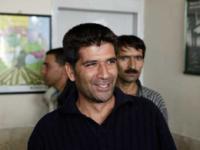
Credit: UNAIDS/P.Virot
The HIV epidemic in the Middle East and North Africa (MENA) region, while seldom highlighted, is steadily growing. In 2008 there were an estimated 310 000 people living with HIV, up from 200 000 in 2001. In that same year, approximately 35 000 people became newly infected with HIV in the region.
UNAIDS Executive Director Mr Michel Sidibé is in the region to draw attention to some of the key issues which need to be addressed to deliver an effective AIDS response, calling on countries to pursue equity and human rights in their approach to the HIV epidemic.
Let’s leverage the solidarity of the global AIDS response to draw closer together as a global family unit to end human suffering and stimulate human achievement.
Michel Sidibé, UNAIDS Executive Director
Stigma and discrimination remains key barriers to an effective regional response to AIDS and in many countries the criminalization of higher risk behaviors pushes affected communities underground–limiting access to HIV prevention, treatment, care and support services.
Given that populations at higher risk are disproportionally affected even in settings where overall HIV prevalence is low, for the good of the public health there is a need for acceptance. “Understanding is an imperative to draw those most at risk out of the shadows and enable them to protect themselves, and by extension, the entire community,” said Mr Sidibé.
UNAIDS’ work in the region
UNAIDS works closely with government and civil society partners in the region to advocate for the removal of punitive laws and polices that block an effective response.
In Yemen, on 29 August, the Parliament voted on a law to protect the rights of people living with HIV with the objective to reduce discrimination. This article 51 law is a major step to protect the rights of individuals living with HIV in the country.
In Egypt, an outreach programme for men who have sex with men has been initiated and in few months the project reached hundreds of people with services in a highly challenging environment. This programme is implemented by UNAIDS in partnerships with number of NGOs and with financial support from USAIDS and the Ford Foundation.
Another positive initiative was the first regional conference on Harm Reduction held in Lebanon last year. This conference was a break-through for the region and brought several experts and partners together and mobilized political support form parliamentarians, national governments and UN agencies.
Service provision for key populations is now also being expanded in the Middle East and North Africa region with oral substitution therapy for Injecting Drug Users programmes in Morocco and Lebanon. In Iran medical insurance is provided for people living with HIV and their families, where the insurance fees are completely paid buy the government. Theses success stories are significant and show investments towards universal access to HIV prevention, treatment, care and support much needed in the region.
Highlighting Human Rights at Qatar Conference
While in the region, Mr Sidibé attended the Colloquium on the Empowerment of the Family in the Modern World held in Doha, Qatar. Hosted by the Royal Family of Qatar and the Qatar Foundation in Doha, the Colloquium brings together scholars to discuss issues such as trends and challenges affecting the family, family and rights, and families around the world.
Families offer the first defence line against stigma and isolation and as well as the primary source of care.
Michel Sidibé, UNAIDS Executive Director
“Families offer the first defence line against stigma and isolation and as well as the primary source of care,” said Mr Sidibé in his key note address. The UNAIDS head also highlighted recent findings from the two year research project of the The Joint Learning Initiative on Children and HIV/AIDS. According to the report families take on approximately 90% of the financial cost of caring for infected and affected children.
Also of key concern is the freedom of movement for people living with HIV, disproportionally affecting migrant workers and their families. Qatar–as many others in the Middle East and North African region– imposes restriction on entry, stay and residence based on HIV status. Such restrictions are widely considered discriminatory and serve no public health benefit.
“Let’s leverage the solidarity of the global AIDS response to draw closer together as a global family unit to end human suffering and stimulate human achievement,” Mr Sidibé concluded his address.
Challenges ahead
To date, a shortage of timely and reliable epidemiological and behavioral data has hindered a clear understanding of the dynamics and trends of the HIV epidemic in the region. Although HIV prevalence remains low, populations at higher risk are often heavily affected; the epidemics in the countries of the region are typically concentrated among injecting drug users, men who have sex with men, sex workers and their clients.
Two broad transmission patterns have been identified. Firstly, many people are contracting HIV while living abroad, often exposing their sexual partners to infection upon their return to their home country. Secondly, HIV transmission is occurring within populations at higher risk such as injecting drug users or men who have sex with men, may also result in ongoing transmission to female sexual partners.
The UNAIDS 2009 AIDS Epidemic Update suggests intensified prevention efforts for the female sexual partners of men who are exposed to HIV during work abroad, drug use, sex with another man or sex with a sex worker.
Spotlight on the Middle East and North Africa Reg
Speeches:
Michel Sidibé, Executive Director of UNAIDS: Families on the Front Line of AIDS
Feature stories:
Middle East and North Africa : News archive
Insight into AIDS responses in Middle East and North Africa (04 Feb 2009)
World AIDS Day marked at Doha conference (01 Dec 2008)
External links:
Qatar Foundation
The Joint Learning Initiative on Children and HIV/AIDS
Publications:
Related

Feature Story
UN Office on Drugs and Crime tackles HIV in prisons
08 December 2009
08 December 2009 08 December 2009
In most countries around the world HIV prevalence is higher among prisoners than in the general population. This is due to a number of factors including the relative lack of knowledge about HIV among prisoners, lack of access to protective measures, often violent conditions, overcrowding and inadequate health services.
To help tackle this situation in Africa, the United Nations Office on Drugs and Crime (UNODC), in partnership with WHO, the World Bank and UNAIDS has launched the African HIV in Prisons Partnership Network (AHPPN).
The initiative was announced at the east and southern Africa consultation which took place on 17 and 18 November 2009. The consultation brought together representatives from prison authorities, civil society, national AIDS councils, health, research and academic institutions, as well as United Nations agencies from 16 African countries.
Responding to the situation in prisons is not only of the essential for those incarcerated but for society as a whole. When released back into the community prisoners who have been vulnerable to HIV infection while in prison may then go on to engage in high risk behaviours outside of prison.
Despite such challenges, strategies to address HIV in prisons are often isolated and not well integrated into national AIDS plans and programmes.
The African HIV in Prisons Partnership Network will support efforts to mount effective, human rights-based responses to HIV in Africa’s prisons. It also hopes to facilitate knowledge sharing and the forging of alliances between a range of partners to encourage a coherent, broad and holistic approach.
We need more comprehensive information about the HIV situation in prisons across Africa...This information should inform the development of evidence-based comprehensive, HIV prevention, care, treatment and support services for men, women and juveniles in prisons and ex-prisoners; without discrimination
Ms. Elizabeth Mataka, the United Nations Secretary-General’s Special Envoy for AIDS in Africa
Championing this need for coordination, Ms. Elizabeth Mataka, the United Nations Secretary-General’s Special Envoy for AIDS in Africa and keynote speaker at the launch noted, “We cannot work in silos…we need everyone, from government officials, National AIDS Councils, law enforcement agencies, civil society organisations, prisoners and former prisoners, to truly reach the objectives of universal access to HIV prevention, treatment, care and support for this particular sub-population, but also with benefits for society-at-large.”
The network will also ensure that existing gaps in knowledge about the true nature and extent of HIV in prison settings are addressed and that the response is based on sound data and evidence.
Ms Mataka added, “We need more comprehensive information about the HIV situation in prisons across Africa...This information should inform the development of evidence-based comprehensive, HIV prevention, care, treatment and support services for men, women and juveniles in prisons and ex-prisoners; without discrimination. These services, it goes without saying, should be of the same quality and standard, as for non-prisoners; and address linkages with the broader community.”
The remit of the African HIV in Prisons Partnership Network is wide and will focus not only on HIV but on tuberculosis, mental health, drug use and prison overcrowding. The network will also provide technical support to member states.
A regional declaration of commitment on AIDS in prisons was adopted at the consultation forum. Informed by the socio-cultural and economic context in Africa, the declaration will be used as a framework for encouraging an effective response to HIV in the region’s prisons.
The Network, which will be supported financially by the Swedish/Norwegian HIV/AIDS Team for Africa, has created a website to share ideas and experiences across the widest possible forum. The site can be accessed at www.ahppn.com.
UN Office on Drugs and Crime tackles HIV in priso
Cosponsors:
Feature stories:
UNODC and Brazil promote action on AIDS in prison settings (22 April 2009)
ICASA 2008: HIV in prison settings
(06 December 2008)
Contact:
Kevin Town
UNODC Southern Africa
Tel: +27-12-342-2424
E-mail: kevin.town@unodc.org
Publications:
HIV and prisons in sub-Saharan Africa (pdf, 2.12 Mb.)

Feature Story
World AIDS Day to be marked by UNAIDS Office in Washington
30 November 2009
30 November 2009 30 November 2009In collaboration with twenty-six civil society organizations, the United Nations Development Programme (UNDP), the United Nations Office on Drugs and Crime (UNODC), the United Nations Population Fund (UNFPA), and the World Bank, UNAIDS is hosting a luncheon on 1 December which completes a policy forum series on HIV, human rights and key at-risk populations.
In recent months UNAIDS has hosted leaders from around the world in Washington, DC to discuss the human rights issues of addressing HIV in three key at-risk populations: men who have sex with men on 16 September; sex workers on 15 October; and people who inject drugs on 12 November. A representative from each population will address human rights and universal access. Civil society representatives will present recommendations to the United States government. U.S. Representative Jim McDermott (Washington State) will give special remarks.
Related
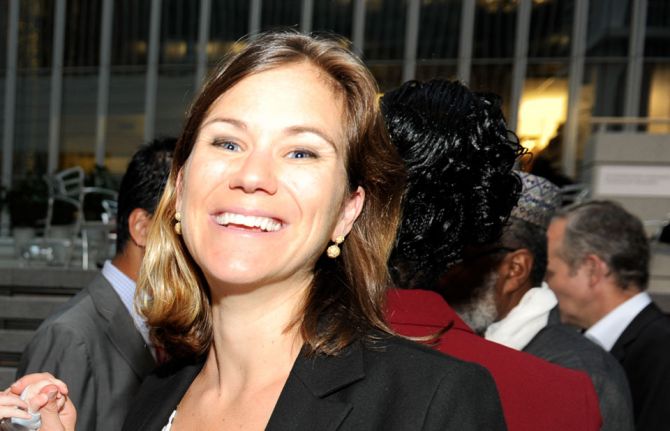 A tribute to Maeve Kennedy Townsend McKean
A tribute to Maeve Kennedy Townsend McKean

09 April 2020
 UNAIDS is awarded the Science and Medicine Award at the 25th Annual Steve Chase Awards
UNAIDS is awarded the Science and Medicine Award at the 25th Annual Steve Chase Awards

12 February 2019
 AIDS care in the Californian desert
AIDS care in the Californian desert
12 February 2019

Feature Story
Advocating for HIV and Hepatitis C co-infection services for injecting drug users in India
15 September 2009
15 September 2009 15 September 2009A version of this story was first published at www.unodc.org

AIDS activist Loon Gangte raises awareness of HIV and Hepatitis C co-infection
Loon Gangte is President of the Delhi Network of Positive People (DNP+) and a strong advocate of HIV and Hepatitis C (HCV) prevention. In an interview with the Regional South Asia office of the United Nations Office on Drugs and Crime (UNODC), he explains why HIV and HCV co-infection, especially among injecting drug users, is an issue needing urgent intervention. He begins with his views on stigma and discrimination.
UNODC: Injecting drug users (IDUs) living with HIV face stigma and discrimination. Why do you think it is important to be open about one's status, as you are?
LG: HIV-positive injecting drug users face a double stigma. They are marginalized and discriminated against on the basis of their drug use as well as their HIV status. In many cases it therefore becomes very difficult for HIV-positive IDUs to be comfortable with themselves. I had been leading a life with drug use for 15 years when I discovered my HIV status in 1998. I could not gather the courage to inform my family for four years because I was concerned about how they would react.
It is like wearing a tight shoe that hurts constantly but no one is aware of your painful situation.
Loon Gangte, President of the Delhi Network of Positive People
It was difficult to break the news but with the help of the young pastor at the church in Churachandpur, I was able to do so. They were shocked but not surprised.
I think it is very important to be open about one's status because it allows you to seek the right kind of medical treatment at the earliest opportunity. Secondly, it encourages others to be open about their own status and seek help. If you don't disclose your status, eventually the one who suffers is you. It is like wearing a tight shoe that hurts constantly but no one is aware of your painful situation. Imagine today if people are not open about their status, there would be no prevention and treatment programmes.
UNODC: Have you personally faced any stigma and discrimination? What is the DNP+ doing to address this problem?
LG: The people I’ve lived and worked with in New Delhi for the past 12 years have been supportive despite knowing my status. However, a couple of years ago, I was patiently standing in a long queue to collect HIV medication in a hospital in New Delhi. It was more than an hour before I finally inched my way to the tiny window and pushed the prescription paper through. During those days, if you were living with HIV, it was stamped prominently 'HIV- Positive', much like a bold seal. Seeing this, the nurse ordered me to the end of the queue again. While I stood back in line, I couldn’t work out why I was being discriminated against. Much later I realized that my HIV-positive status compelled her to single me out and treat me differently. I did not understand this right away since for me being HIV-positive did not mean that my rights have to be taken away. I am like any other person; if you cut my skin it will bleed, I have aspirations, the organs in my body function very much like any other man's. The presence of a tiny virus cannot make anyone take away my fundamental rights.
Because Hepatitis C and HIV have similar routes of transmission (particularly through needle sharing), co-infection is common among injecting drug users.
Loon Gangte, President of the Delhi Network of Positive People
The Delhi Network of Positive People has been working on treatment advocacy and towards reducing the stigma and discrimination faced by people living with HIV. Whenever any instance of discrimination is faced by members, DNP+, with help from the Lawyers Collective, intervenes and addresses the issue immediately, whether it is at the workplace, hospital, school or in the family. As part of their work they have Positive Speakers who highlight incidents of stigma and discrimination at various conferences as well as in workshops, school meetings, trainings and discussions. This helps bring attention to the issues faced by HIV-positive people. To address self stigma, DNP+ has started a self help group to provide those living with HIV with safe spaces to meet, interact and share experiences. Over a period of time members of the support groups become active members of DNP+ and champion the rights of those who are HIV-positive.
UNODC: You are also living with Hepatitis C infection. Describe your experiences in accessing treatment for HCV.
LG: Having both HIV and Hepatitis C is referred to as co-infection. I was diagnosed with this co- infection two years ago. I have been lucky that I have got funding through the International Treatment Preparedness Coalition for periodic Hep C testing. I am not on treatment currently. Hep C infection spreads rapidly among injecting drug users due to its high infectivity (about 10 times higher than HIV, and—unlike HIV—it can be transmitted by sharing not only needles and syringes, but also other injecting equipment such as water, cotton, etc). Because HCV and HIV have similar routes of transmission (particularly through needle sharing), co-infection is common among injecting drug users. Co-infection causes further complications, accelerates HCV progression and makes HIV treatment more difficult.
At the same time, HCV often presents no symptoms, and the vast majority of IDUs are not aware of their status as this group is not being reached by services and remains outside of the health care system. Thus, for universal access to be fully realized, treatment for HIV and HCV co–infection must be provided.
UNODC: Why is advocating for HCV treatment in India so important?
LG: One study estimates that 92% of injecting drug users is infected with Hepatitis C in India . Rates of HCV and HIV co-infection are high, especially in the north east of the country. The state of Manipur is worst affected . Currently there is no official, national or state-wide surveillance for Hep C in India. I have personally noticed that many of those infected with HIV are also infected with HCV. Despite considerable prevalence, HCV diagnosis, treatment and care are largely inaccessible here.
The biggest challenge is to raise awareness about HCV and HIV co-infection among drug users and health professionals. The test for Hep C is costly and ranges from US $1200 - US $2100 in India. Testing for HCV can be included as part of the anonymous testing for HIV being provided through Integrated Counselling and Testing Centres.
The medications used in HCV treatment, pegylated interferon and ribaviron, are expensive. A six month course costs between US$ 4 000—5 000; the lifetime income of some Indians. Unlike HIV, where first line Antiretroviral Therapy (ART) is provided free, there is no government support or subsidy for HCV treatment. Ironically, in Manipur where HCV and HIV co-infection is high, patients are dying of liver complications, despite treatment with and adherence to ART.
The WHO, UNAIDS and UNODC target setting guidelines for countries now include treatment for Hepatitis B and C as part of the comprehensive package of services for drug users. As always, prevention is key in arresting transmission. The national and public health systems need to be supported to prevent blood-borne transmission and provide HCV treatment, regardless of cost and if possible free of cost: many infected with Hepatitis C cannot afford the cost of testing and treatment. Prices of drugs for HCV have to be drastically reduced.
UNODC works in India on HIV prevention, care and treatment for injecting drug users and prison population. UNODC works with Government counterparts, non governmental organizations, networks of people who use drugs, and people living with HIV and advocates for delivering comprehensive packages of services.
1 Aceijas C.Rhodes T Global estimates of HCV among Injecting Drug Users. Int Journal of Drug Policy 2007,18(5),352-358
2 Sarkar K, Bal B, Mukherjee R, Chakarabortys, Bhattacharya SK, Epidemic of HIV coupled with HCV Injecting drug users in west Bengal, Eastern India bordering Nepal, Bhutan and Bangladesh, Substance Use Misuse 2006, 41(3);341-52
Advocating for HIV and Hepatitis C co-infection s
Cosponsors:
Feature stories:
Injecting drug users take central role in anti-stigma film (10 August 2009)
International Harm Reduction conference opens in Bangkok (20 April 2009)
OPINION: HIV and drugs: two epidemics - one combined strategy (20 April 2009)
UNODC and Iran sign agreements to reduce vulnerability of women and Afghan refugees to drugs and HIV (24 March 2009)
Injecting drug use and HIV: Interview with UNAIDS Team Leader, Prevention, Care and Support team (11 march 2009)
OPINION: Silence on harm reduction not an option (11 March 2009)
Publications:

Feature Story
UNAIDS Cosponsors out in force for 9th ICAAP
09 August 2009
09 August 2009 09 August 2009
The 10 UNAIDS Cosponsors are presenting a strong showing as thousands of delegates converge in Bali, Indonesia, to share ideas, knowledge, best practices, lessons learned and research findings at the 9th International Congress on AIDS in Asia and the Pacific (ICAAP).
The Cosponsors are an integral part of the UN’s response to the global AIDS epidemic and UNAIDS brings together their efforts and resources.
Echoing the Congress theme, ‘Empowering people - strengthening networks’, the Cosponsors are organising and presenting symposia, skills-building workshops and satellite meetings drawing together a number of participants from a range of disciplines with the aim of helping to build and nurture partnerships to bolster the AIDS response in the region.
A number of events are joint Cosponsor initiatives. For example, the Symposium on ‘HIV prevention and most at risk young people’, taking place on 10 August, is sponsored by UNFPA, UNICEF, UNESCO, UNDP, WHO and UNAIDS. The symposium, hosted by the Asia Pacific Regional UN Coordination Group on Most at Risk Young People, is designed to look at the specific needs of this population which is, in general, not being reached by HIV prevention services. This includes injecting drug users, men who have sex with men and sex workers and their clients. Representatives from these groups will also take part in the panel discussion –one further example of how Cosponsor ICAAP activities are designed to involve key populations.
Other examples of Cosponsor activities include UNDP, ILO and UNAIDS (with the Joint United Nations Initiative on Mobility and HIV/AIDS in South East Asia) collaborating on a joint symposium on 12 August entitled, ‘The Impact of the Financial Crisis on Labour Migration and HIV’ in which they will bring their respective expertise to bear on this pressing international issue. UNHCR, along with UNAIDS, is hosting a satellite session on 12 August called ‘Opportunities and challenges in addressing HIV amongst diverse humanitarian populations’. WFP will use a satellite session on 11 August to explore the vital role of nutrition and food security for people living with HIV and will, along with its partners, look at ‘Models for integrating nutrition and food security into HIV care, support and treatment in the Asia Region: Opportunities and challenges’.
The World Bank is also championing the screening, on 10 August, of the film, Suee (Needle) by Cannes Film Festival award winner, Sai Paranjpye, which deals with the lives of injecting drug users and the anti-AIDS stigma they face. The film emerged from the South Asia Region Development Marketplace, a grant programme spearheaded by the Bank and supported by a range of partners including UNAIDS, UNICEF, UNODC and UNDP.
There is an extremely broad range of other Cosponsor activities taking place over the five days of the Congress and a number of these events will be highlighted on the UNAIDS website as the ICAAP progresses.
UNAIDS and its ten Cosponsors work to provide technical support to countries to assist them in the implementation of their national AIDS plans. A ‘division of labour’ guides the technical support provided to enhance coordination, avoid duplication and provide the best assistance available. Each of the Cosponsor organizations leads in at least one technical area. These organizations are:
Office of the United Nations High Commissioner for Refugees (UNHCR)
United Nations Children's Fund (UNICEF)
United Nations Development Programme (UNDP)
United Nations Population Fund (UNFPA)
United Nations Office on Drugs and Crime (UNODC)
International Labour Organization (ILO)
United Nations Educational, Scientific and Cultural Organization (UNESCO)

Feature Story
UNODC and Brazil promote action on AIDS in prison settings
22 April 2009
22 April 2009 22 April 2009A version of this story is also published at UNODC.org

The first national consultation on HIV in prison settings took place in Brasilia 31 March to 2 April 2009.
Credit: UNODC
Much more needs to be done to improve AIDS prevention, treatment and care services in Brazil’s prisons. This was the major conclusion emerging from the first national consultation on HIV in prison settings which took place in Brasilia between 31 March and 2 April.
Organized by Brazil's Ministry of Health and Ministry of Justice in partnership with the United Nations Office on Drugs and Crime (UNODC), the objective of the consultation was to discuss and propose an agenda with an action plan to provide prevention, treatment, care and support services aimed at addressing HIV, other sexually transmitted infections and co-infections such as tuberculosis and hepatitis in prisons.
"UNODC is committed to supporting the Government of Brazil in the provision of HIV prevention and care services to the prison population," said UNODC Representative for Brazil and the Southern Cone, Giovanni Quaglia.
The national consultation was attended by around 150 professionals. These included specialists from the key ministries, representatives from all 26 states of Brazil and the Federal District (where the capital is located), health professionals working in prison settings, members of the national harm reduction network, representatives of the Brazilian segment of the International Commission for Catholic Prison Pastoral Care and members of the National Network of People Living with HIV/AIDS.
UNODC is committed to supporting the Government of Brazil in the provision of HIV prevention and care services to the prison population.
Giovanni Quaglia, UNODC Representative for Brazil and the Southern Cone
As in most countries, Brazil has a higher HIV prevalence in the prison population than among the general population. According to the most recent research, a local study published in 2007, found rates of 5.7% among certain prisoners. In contrast, UNAIDS reports that by the end of 2007, general adult prevalence was 0.6%.
It is estimated that the country has approximately 420,000 prisoners living in often violent conditions where overcrowding, lack of access to medical services and unsanitary surroundings can lead to greater vulnerability to HIV and other infectious viruses such as tuberculosis and hepatitis. These conditions can also increase AIDS-related deaths and undermine attempts to implement an effective response to the epidemic in prisons.
Liliana Pittaluga, Technical Adviser at the Prevention Unit of the National STD and AIDS Programme, said that the consultation was a symbol of the solid partnership between the Government of Brazil and UNODC. "The cooperation between sectors is crucial to improve the health care and prevention services made available inside prison settings. We are confident that the results of this consultation will not only result in an exchange of experiences, but also in building a process of actions that will have a positive effect in the prison system at the country level."
The main outcome of the consultation was the commitment made by the Ministry of Health, the Ministry of Justice and UNODC to form a working group which will design a national operative plan with guidelines, targets and deadlines. In addition, civil society organizations, the Pan-American Health Organization (PAHO) and UNAIDS will be part of this group.
As well as UNODC, UNAIDS and PAHO/World Health Organization, also participating in the meeting were the United Nations Educational, Scientific and Cultural Organization (UNESCO) and the United Nations Population Fund (UNFPA). Health and justice experts from the Southern Cone region also attended as observers, at the invitation of UNODC.
Right Hand Content
Cosponsors:
Feature stories:
ICASA 2008: HIV in prison settings (06 December 2008)
Publications:
HIV and prisons in sub-Saharan Africa (pdf, 2.12 Mb)

Feature Story
Joint action for results: UNAIDS outcome framework, 2009 – 2011
22 April 2009
22 April 2009 22 April 2009
The HIV organizational landscape has evolved and grown more complex over the past decade. UNAIDS, donors and civil society, including networks of people living with HIV, have rightly demanded greater clarity on the relationships between needs, financing, activities and outcomes. Also demanded is greater specificity about the role of UNAIDS and the Secretariat within the wider constellation of actors.
This Outcome Framework, which builds upon the UNAIDS Strategic Framework (2007–2011), will guide future investment and hold the Secretariat and the Cosponsors accountable for making the resources of the UN work for results in countries. It affirms the UNAIDS Secretariat and Cosponsors to leverage our respective organizational mandates and resources to work collectively to deliver results.
Joint action for results: UNAIDS outcome framework, 2009 – 2011 (pdf, 388 Kb)
Joint action for results: UNAIDS outcome framewor
Cosponsors:
Office of the United Nations High Commissioner for Refugees (UNHCR)
United Nations Children's Fund (UNICEF)
World Food Programme (WFP)
United Nations Development Programme (UNDP)
United Nations Population Fund (UNFPA)
United Nations Office on Drugs and Crime (UNODC)
International Labour Organization (ILO)
United Nations Educational, Scientific and Cultural Organization (UNESCO)
World Health Organization (WHO)
World Bank
Publications:
Joint action for results: UNAIDS outcome framework, 2009 – 2011 (pdf, 388 Kb)

